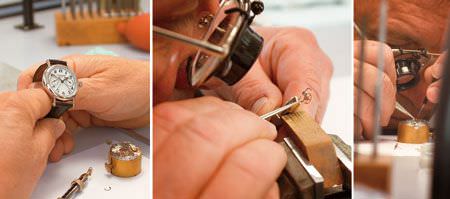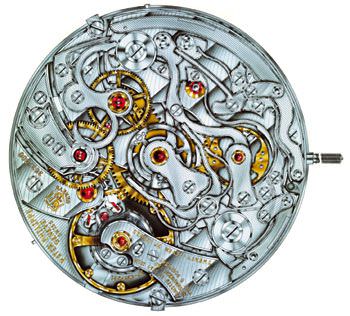Under this rather dry-sounding name, can be found the world’s flattest column-wheel chronograph movement, with a thickness of 5.25 mm. This is a grand premiere because up to now, as a base for its chronographs, Patek Philippe had used a Nouvelle Lémania calibre produced exclusively for the Geneva brand. Based on the CH 27-70, the movement gradually added a perpetual calendar and a continuous flyback function. However, Patek Philippe decided to complete its offer by designing and producing à l'ancienne a new basic and very prestigious chronograph flyback calibre of its own. By the way, this complication ranks as one of the most complex in the world.

“A l'ancienne”
This new movement, while it includes a number of innovations, still follows the historical path of the most authentic watchmaking traditions. Testifying to this are the perfectly chamfered, polished and decorated bridges and component parts; the angles formed as only an experienced artisan can do; the two column-wheels with polished protective caps; attention to other details such as the rubies chased into gold settings; and its architecture itself inspired by a historic Patek Philippe movement from 1903.
Its particular mode of fabrication follows the same spirit of remaining true to tradition. It has been entrusted to the brand’s new Haute Horlogerie section. This section is made up of small ateliers of five to six master watchmakers who concentrate on only one type of complication. There, each component part is terminated, filed, chamfered, polished and adjusted by hand. As in the time of the ‘companions’, the movement is assembled a first time, checked and then taken apart, cleaned, and then re-adjusted if ne-cessary before being put back together.

Innovations
But this manual approach à l'ancienne does not, in any way, exclude innovation. The teeth of the chronograph’s gear wheels have been given a new and patented shape, designed to: reduce the play between the teeth; avoid vacillations of the chronograph hand; remove the risk of a hand jumping forward or backward; increase efficiency; and decrease friction. In the long run, reliability is improved because this new tooth shape also reduces the wear and tear inside the mechanism.
Another performance feat: the reduction of the movement’s thickness to 5.25 mm means that this flyback chronograph is the flattest ever realized. Within the scope of this article, it is difficult to go into all the technical details, but simply put, the special design of the minute counter allows it to advance in a continuous manner, not just in single jumps after each minute, thus enabling a reduction in thickness at this point. This continuity, permitting a 60-minute counter, is assured by its direct contact with the cannon-pinion (pinion that drives the minute hand and that makes one rotation in one hour).
Another innovation is that this new flyback chronograph has only two pushbuttons instead of the normal three. The one on the crown activates the counting, stops it and sends the hand back to zero. The second pushbutton, located between 1 and 2 o’clock, commands the flyback. This system thus allows, in addition to normal flyback chronometry, the intermediate (or reference) time on the flyback to be preserved while measuring other times with the chronograph.
As we can see, high tradition and advanced innovation blend well together in this very lovely realization that, for its first series, is limited to ten models, enclosed in a platinum case in the traditional ‘Officer’ style. There is no doubt that this movement has a long and wonderful future ahead of it.
Source: June -July 2005 Issue
Click here to subscribe to Europa Star Magazine.




